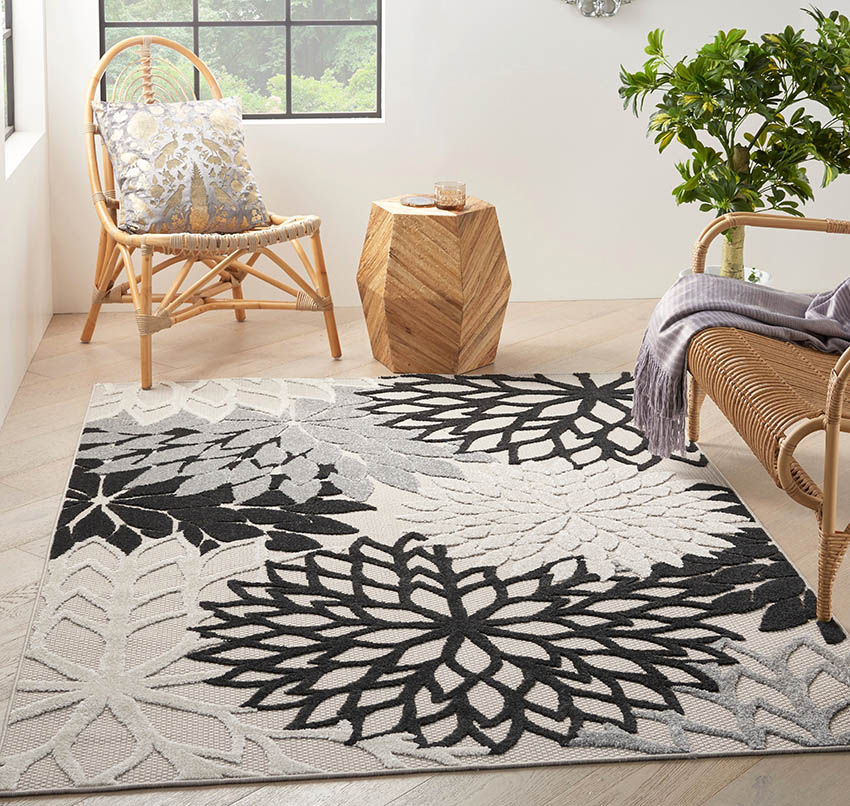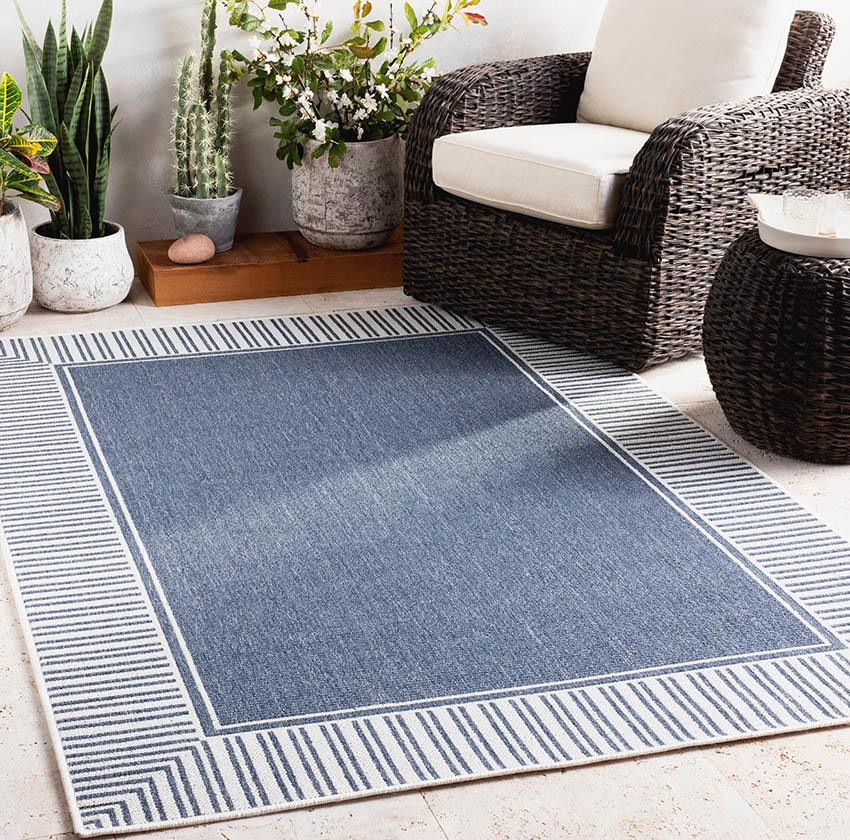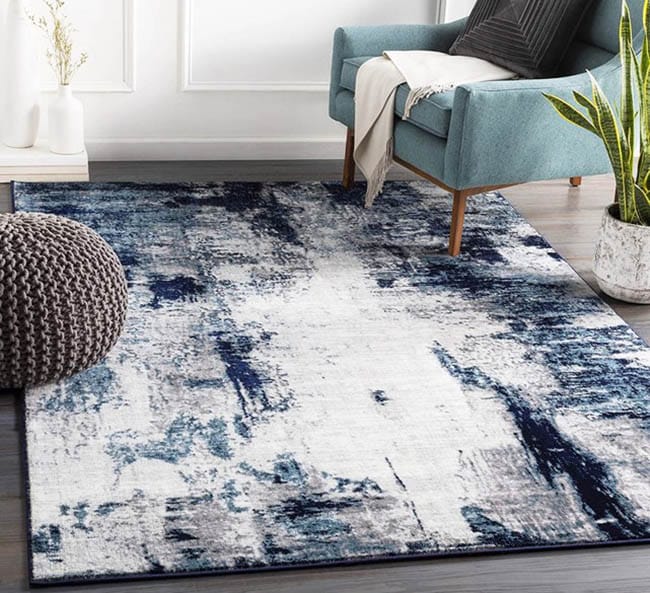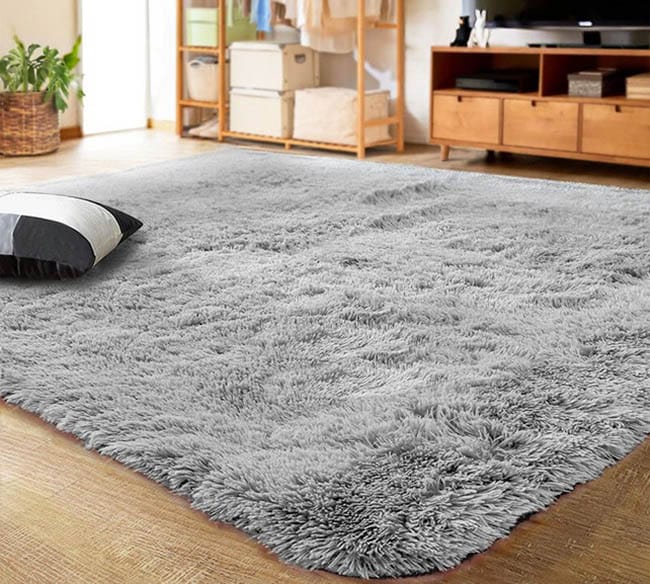Polyester Rugs Pros and Cons
Here’s our guide to polyester rugs, pros and cons, including different types and how to clean.
Tacky-looking no more, the polyester of today is more versatile than ever, making it available for a wide range of applications. One of the products that fully takes advantage of the innovations in materials is polyester rugs.
These soft and durable floor coverings are not only high-performing but also have a surprisingly lower ecological footprint compared to other fabrics, such as cotton. You can even choose recycled polyester, which reduces the need for new production.
Polyester Rugs Pros and Cons
This material is a fairly good product for those looking for a bargain rug. They cost less than rugs made out of nylon and natural fibers.
Here are the pros and cons, starting with the pros first.
Advantages of Polyester-Made Rugs

The lush nature of this fabric, when it is made appropriately, will feel very soft on your feet when it is a rug. If you have ever felt a high-quality microfiber material before, then you have an idea of what this experience is like at home.
Although there can be a few challenges with cleaning since vacuums can develop static charges over this material, you can avoid them by brushing out the strands. Professional cleaners can also help you to keep the materials clean over time without difficulty.
Durable Rug. Durability is what this material has always been known for, and expect to enjoy your fabric rug for around 5 to 10 years, but it will vary depending on the quality and foot traffic on your rug.
Wide Range of Choices. The versatility of this material means you can get a wide range of choices that can suit your preferences.
For instance, you can get super-soft rugs that are ideal for bedrooms, living rooms, and offices.
No Bacterial Growth – These rugs will dry quicker compared to other rug materials, making it a preferable option for bathrooms and kitchens that get a lot of humidity and liquid spills.
Aside from the quick-drying feature of such fabric rugs, there are products with new treatments that prevent microbial growth and thus control unwanted odors.
Washing Machine Ready – Reasonably sized rugs can also be machine washed without damaging the fibers.
Recyclable – These can be recycled or can be made of other PET-made products, such as plastic bottles. Recycled polyester rugs make car parts, insulation, and sofa stuffing.
An Affordable Rug – They are more affordable than nylon and natural fibers but with good quality. Visit our breakdown of nylon vs polyester carpet here.
This makes these rugs a sensible choice for startup homes and people who are just starting to furnish their first homes or apartments.
Disadvantages of Rugs Made of Polyester
It Can Be Stained by Oil-based Liquids. As floor mats made of this fabric are generally stain-resistant, oil-based stains are another matter.
You may need to get professional help in getting rid of these stubborn stains or get a premium-made rug that can resist most stains and can be cleaned easily.
Can Degrade Under Constant UV Exposure. Direct and long-term exposure to the sun can fade away the color of your rug.
It Can Be a Source of Pollution. While these mats can be recycled and can be made from recycled PET products, the microplastic that is shed microfibers can be a source of pollution.
There is a need for constant vacuuming during the production process to prevent this minute plastic debris from getting to bodies of water and soil.
What Is a 100% Polyester Labeled Rug?

A label with 100% polyester says that your rug is entirely made of polyester. Take note, though, that this material can have a static build-up, especially when placing it in a dryer. To prevent this, you can add a fabric softener when washing.
See our post about the types of carpets for more alternatives to polyester.
Is Polyester Toxic?
Polyester floor mats are made of plastics made from PET plastics or polyethylene terephthalate. PET plastics contain contaminants that are harmful to humans and the environment when ingested.
Though, at present, there is no documented proof that PET carpet fibers do have harmful effects on their users, it’s best to keep the fibers from your mouth and nose.
Frequent vacuuming and general maintenance at least once a week are recommended to prevent dust and particulates from circulating in your indoor air.
Are Polyester Carpets and Rugs Safe?
Those made from polyester are generally safe, and when following the recommended regular vacuuming of fibers and maintenance, they won’t pose a threat to users.
Find reputable brands for your floor mats that have been tested to meet indoor air quality set by the U.S. Environmental Protection Agency.
How to Clean a Polyester Rug?
Cleaning a fabric rug is a straightforward process. The frequency of cleaning depends on the volume of traffic, the location of your rug, and the type of rug you have.
Daily Cleaning – Shaking off your rug to remove debris and prevent particles from settling in the rug strands.
Weekly Cleaning – Vacuum both sides of your rug to loosen up dirt and debris. You can vacuum a few times a week to maintain a clean rug, especially for high-traffic areas.
Spot Cleaning – Removing excess moisture and dampness prevents the accumulation of dirt on the mat. You should spot-clean regularly, especially in busy areas such as floor mats in kitchens or bathrooms.
It’s also best to spot clean, especially if you’ve got a pet dog or cat. Wipe off with a damp cloth soaked in a mix of water and detergent, which will help you thoroughly clean the spot.
Deep Cleaning – Pour water on your rug to wash off and loosen up accumulated dirt, then mix detergent with water to be applied on your rug.
In a bucket with water and detergent, you can further lose up debris by allowing your floor mat to soak in the said mixture for a few hours or overnight.
Then, you can use a high-pressure water hose to remove the loosened dirt. Make sure to test your mixture by applying it on a portion of your mat before applying it to the entire thing.
Machine Wash – There are fabric floor mats that you can machine wash. Make sure to see the label for instructions on what detergent is allowed and if it is recommended to use warm water instead.
Other Methods: Use dry shampoo or steam clean.
How to Wash a Polyester Shaggy Rug?

Washing this kind of floor covering can be more challenging than polyesters with short hairs as the fibers can get entangled.
You can still use methods similar to those on short-haired polyester ones, especially if you have a small area to clean. Also, check if your shaggy floor mat is machine washable.
However, most shaggy floor mats with rubber backing plates may not be machine washable, so make sure to check instructions and labeling before washing your floor mat. Using dry shampoo and steam cleaning are also easier methods to use for larger, shaggy floor mats.
Added tip. When vacuuming your shaggy mat, disable the beater bar on your vacuum and use the suction function only.
What do you think about these floor mat pros and cons? Let us know what you think about polyester mats in the comments. Visit this article for more details on how to choose rug sizes.






